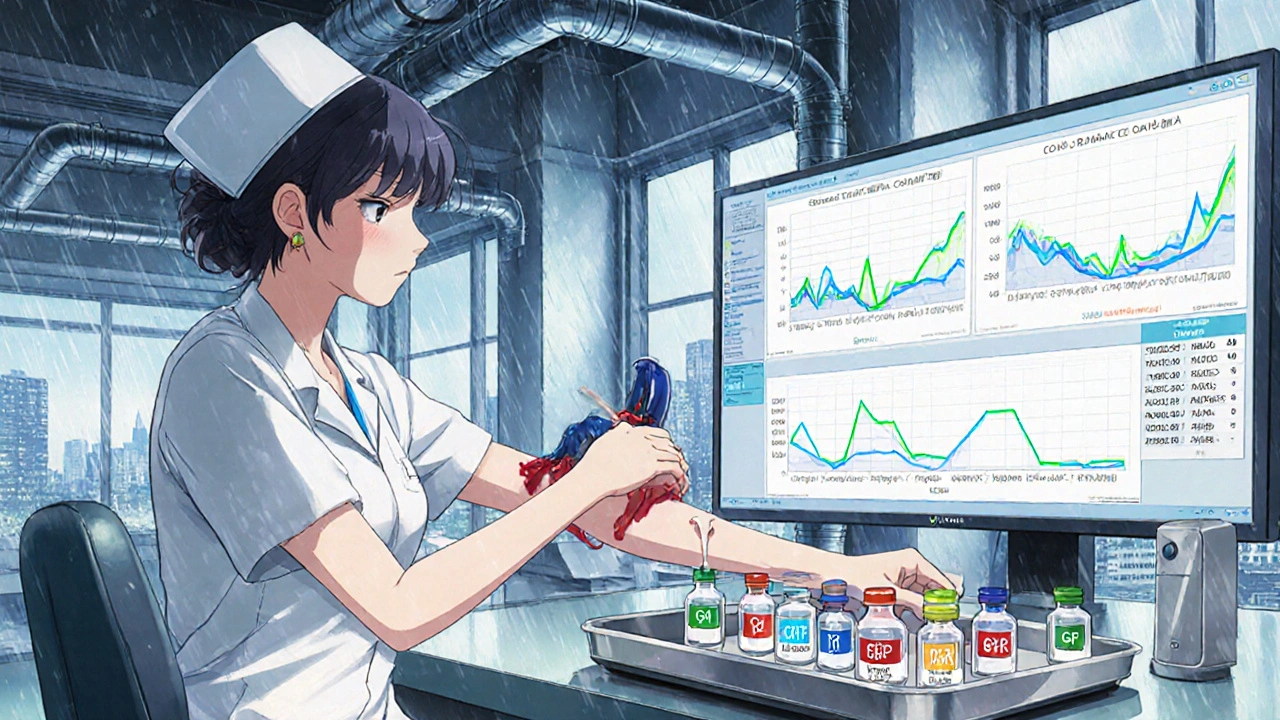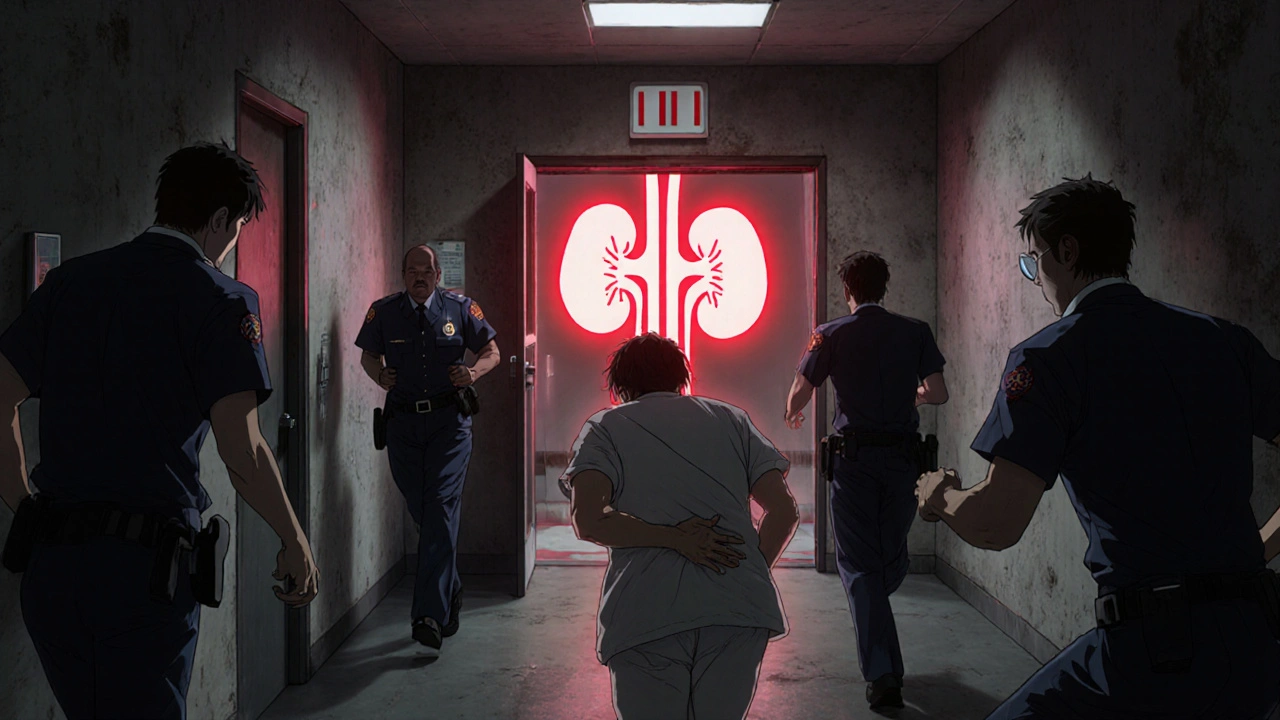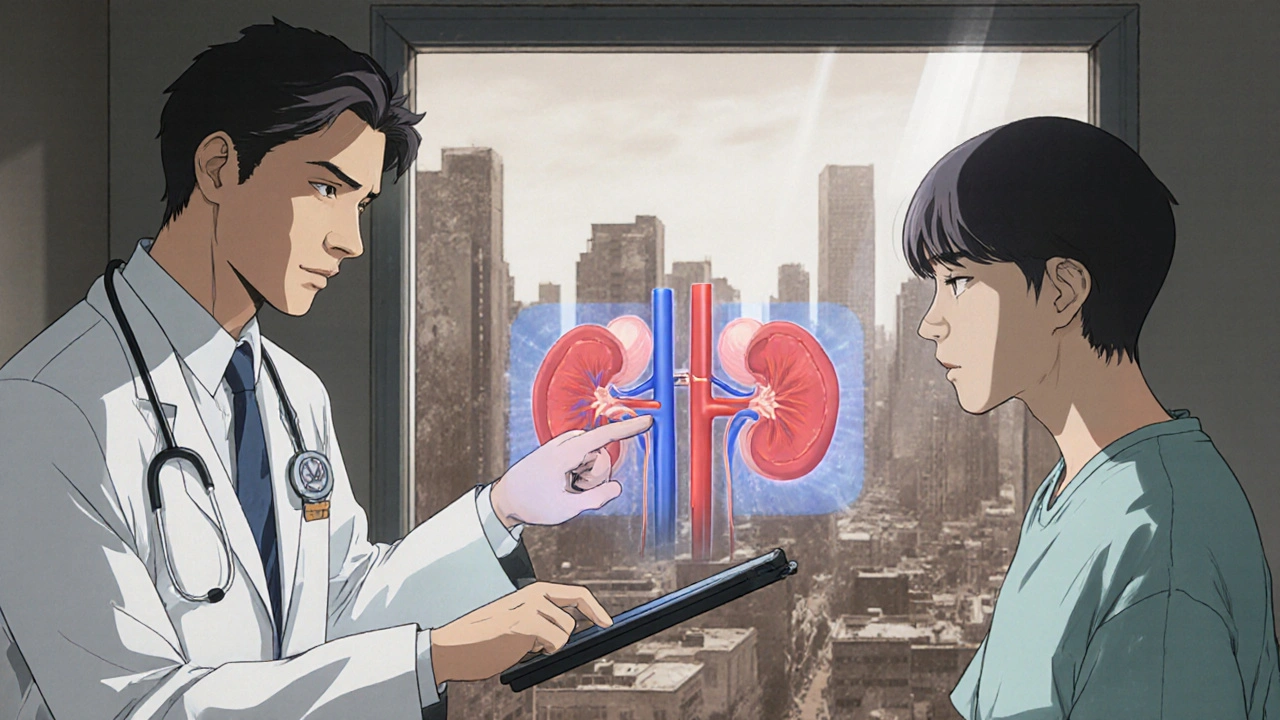Tobramycin Kidney Risk Calculator
Assess Your Kidney Risk
This calculator estimates your risk level when taking tobramycin based on key factors from the article. Use it to understand your monitoring needs.
Your Kidney Risk Assessment
Recommended Monitoring Schedule
| Time | Tests | Frequency |
|---|---|---|
| Baseline | Creminine, BUN, GFR | Immediately |
| Day 3 | Creminine | Every 24-48 hours |
| Days 5-7 | Creminine, GFR | Every 48-72 hours |
| End of therapy | All three | Once completed |
Key Takeaways
- tobramycin can cause kidney damage, especially at high doses or with prolonged use.
- Baseline and regular lab tests (creatinine, GFR, BUN) help catch problems early.
- Therapeutic drug monitoring (TDM) guides safe dosing adjustments.
- Patients with pre‑existing kidney issues, diabetes, or dehydration need extra caution.
- Act quickly if you notice reduced urine output, swelling, or unusual fatigue.
When a doctor prescribes the antibiotic Tobramycin is an aminoglycoside used to treat serious gram‑negative infections such as pneumonia, urinary‑tract infections, and sepsis, the focus is on killing bacteria fast. But there’s a hidden side: the drug can stress the kidneys. If you’re on tobramycin, keeping an eye on kidney function isn’t optional-it’s a must‑do step that can mean the difference between recovery and a new health problem.
Kidney function refers to the kidneys’ ability to filter waste, balance fluids, and regulate electrolytes. Doctors measure it with blood tests like serum creatinine and calculate the glomerular filtration rate (GFR). When tobramycin enters the bloodstream, it’s filtered by the kidneys, and that filtering process can sometimes cause damage, especially if the kidneys are already compromised.
How Tobramycin Affects the Kidneys
tobramycin belongs to the aminoglycoside class, which is known for its potent antibacterial action but also for a risk of nephrotoxicity. The drug accumulates in the renal tubular cells, leading to oxidative stress and inflammation. Over time, this can reduce the glomerular filtration rate and raise serum creatinine levels, signaling an acute kidney injury (AKI).
The damage isn’t always obvious. Early signs can be subtle-slight changes in lab values or a mild drop in urine output. That’s why regular monitoring is essential, even if you feel fine.
Who Is at Higher Risk?
- Pre‑existing kidney disease: Reduced baseline GFR means the kidneys have less reserve to handle the drug.
- Older adults: Age‑related decline in renal function makes dosing trickier.
- Diabetes or hypertension: Both conditions can impair kidney health over time.
- Dehydration or low blood pressure: Less blood flow to the kidneys heightens toxicity risk.
- Concurrent nephrotoxic drugs: Medications like vancomycin, NSAIDs, or certain contrast agents add to the load.
If any of these apply to you, your doctor will likely schedule more frequent lab checks.

Monitoring Basics: What Tests, When, and Why
The core monitoring trio includes serum creatinine, blood urea nitrogen (BUN), and the calculated GFR. Some clinics also measure cystatin C for a more precise GFR estimate.
| Day | Test | Purpose |
|---|---|---|
| 0 (baseline) | Serum creatinine, BUN, GFR | Establish starting point |
| 3 | Serum creatinine | Detect early rise |
| 5‑7 | Serum creatinine, GFR | Confirm trend |
| Every 48‑72 h thereafter | Serum creatinine, BUN | Ongoing safety check |
| End of therapy | All three | Ensure recovery |
Therapeutic drug monitoring (TDM) adds another layer. By measuring trough and peak levels of tobramycin in the blood, clinicians can fine‑tune the dose to stay within the therapeutic window (typically 5‑10 µg/mL peak, < 2 µg/mL trough). When kidney function drops, the drug clears more slowly, so TDM helps prevent accumulation.
Interpreting Lab Results and Adjusting Dose
When creatinine climbs by more than 0.3 mg/dL within 48 hours, or GFR drops below 30 mL/min, it’s a red flag. The usual response is to reduce the daily dose or extend the dosing interval. For example, a patient receiving 5 mg/kg once daily might be switched to 3 mg/kg every 48 hours if GFR falls to 25 mL/min.
Renal dosing guidelines often use the Cockcroft‑Gault equation or the Modification of Diet in Renal Disease (MDRD) formula to estimate clearance. The key is to match the drug exposure to the kidney’s ability to excrete it.

Practical Checklist for Patients and Clinicians
- Get a baseline serum creatinine and GFR before the first dose.
- Schedule lab draws on days 3, 5‑7, and then every 2‑3 days.
- Ask the lab to report both creatinine and calculated GFR.
- Ensure the pharmacy draws a trough level just before the next dose.
- Record any symptoms: reduced urine output, swelling, nausea, or unusual tiredness.
- If a lab value is out of range, contact your clinician before the next dose.
- Never stop tobramycin on your own-stopping abruptly can cause a rebound infection.
When to Seek Immediate Medical Attention
If you notice any of the following, call your doctor or go to the emergency department right away:
- Sharp pain in the side or back (possible kidney swelling).
- Sudden drop in urine volume.
- Swelling in ankles, feet, or face.
- Persistent nausea, vomiting, or loss of appetite.
- Confusion or difficulty staying awake.
These signs could signal an acute kidney injury that needs rapid intervention, such as dose reduction, hydration, or switching to a different antibiotic.
Bottom Line
tobramycin is a life‑saving drug, but its power comes with a kidney‑toxicity risk. By establishing a baseline, following a clear lab‑testing schedule, using therapeutic drug monitoring, and acting quickly on any abnormal results, patients and clinicians can keep the kidneys safe while still beating the infection.
How often should I get blood tests while on tobramycin?
A typical schedule is a baseline test before the first dose, then a repeat on day 3, another on days 5‑7, and every 48‑72 hours thereafter. The exact timing may change if your kidney function is already low or if you develop symptoms.
Can I take over‑the‑counter pain relievers while on tobramycin?
Avoid NSAIDs such as ibuprofen because they also stress the kidneys. Acetaminophen is generally safer, but keep the dose within recommended limits and let your doctor know.
What is the difference between serum creatinine and GFR?
Serum creatinine is a blood measurement of a waste product filtered by the kidneys. GFR is a calculated estimate (usually in mL/min) of how much blood the kidneys filter each minute. GFR gives a more complete picture of kidney health.
Is it safe to stay hydrated while taking tobramycin?
Yes, staying well‑hydrated helps the kidneys clear the drug faster and reduces the chance of toxicity. Aim for the fluid intake your doctor recommends, especially if you have heart‑failure or fluid‑restriction orders.
What should I do if my lab results show a rise in creatinine?
Contact your healthcare provider immediately. They may pause the drug, reduce the dose, increase the dosing interval, or switch to a non‑nephrotoxic antibiotic, depending on the severity of the rise.

Esther Olabisi
Totally agree, monitoring those kidney labs is like the ultimate cheat code for staying alive while on a hardcore antibiotic 😅. If you skip the day‑3 check, you might as well be playing Russian roulette with your nephrons. Keep that hydration game strong, and don’t forget to tell the pharmacy to pull a trough level right before the next dose. Bottom line: better safe than sorry, especially when your kidneys are doing the heavy lifting.
Ivan Laney
When one considers the pharmacokinetic profile of tobramycin, it becomes abundantly clear that any cavalier approach to renal monitoring is a direct affront to the principles of responsible medicine. The drug’s propensity to accumulate within the proximal tubular epithelium, generating oxidative stress, is a well‑documented phenomenon that should alarm any clinician with a pulse. In the United States, where the health care system is already burdened by unnecessary complications, ignoring a simple serum creatinine check is tantamount to bureaucratic negligence. Moreover, the American public deserves transparency about the risks of nephrotoxicity, especially when the medication is prescribed for infections that could potentially be treated with less hazardous alternatives. A baseline glomerular filtration rate, obtained before the first dose, establishes a reference point that informs dosage adjustments throughout the therapeutic course. The recommended day‑3 creatinine measurement is not a suggestion but a cornerstone of the monitoring schedule, designed to catch early rises before irreversible damage sets in. If the creatinine climbs by more than 0.3 mg/dL within 48 hours, the clinician must immediately reassess the dosing interval or consider a different antibiotic altogether. Failure to adhere to this protocol not only jeopardizes renal function but also inflates health‑care costs due to prolonged hospital stays and potential dialysis. Therapeutic drug monitoring, including trough and peak levels, provides an additional safety net that aligns drug exposure with the patient’s renal clearance capacity. In practice, many physicians overlook the trough level, assuming that standard dosing regimens are universally safe, which is a myth that has been debunked in numerous peer‑reviewed studies. The integration of cystatin C measurements can further refine GFR estimates, especially in patients with atypical muscle mass where creatinine may be misleading. For patients with pre‑existing chronic kidney disease, the dosing algorithm must be calibrated using the Cockcroft‑Gault equation or MDRD formula, not merely rounded to the nearest milligram. Neglecting these calculations is not just an oversight; it is a breach of the fiduciary duty owed to the patient. In my experience, institutions that implement a strict monitoring protocol see a dramatic reduction in acute kidney injury rates associated with aminoglycosides. Therefore, the mantra should be simple: monitor early, adjust promptly, and never assume safety without data. Any deviation from this evidence‑based pathway is, frankly, an irresponsible gamble with the patient’s renal health.
Kimberly Lloyd
I hear you, and it’s reassuring to see the science laid out so clearly. It reminds me that behind every lab value is a person hoping to get better without extra baggage. Staying vigilant feels like a quiet act of self‑care, even if it seems routine. Let’s keep the conversation grounded in compassion.
Sakib Shaikh
Yo dude, tobramycin is like a fire‑breathing dragon for your kidneys if u dont watch ur labs. The drugpumps into the nephron like crazy and can melt the tubules, no joke. So get those blood tests on day 3, 5‑7, or u’ll be in trouble. Trust me, i’ve seen it happen!
Devendra Tripathi
Honestly, I think all this hype about kidney monitoring is overblown; most patients tolerate tobramycin just fine. If you’re constantly checking labs, you’re just adding anxiety for no real benefit. Besides, the drug’s efficacy outweighs a minor rise in creatinine. People need to chill out on the paranoia.
Vivian Annastasia
Oh great, another reminder that we need to treat a life‑saving antibiotic like a bomb. Because nothing says ‘I trust my doctor’ like a spreadsheet of creatinine numbers every two days. Still, if you enjoy watching numbers dance, go ahead and schedule those tests. It’ll keep your therapist busy.
John Price
Just keep hydrated and follow the day‑3 lab schedule.
Nick M
You’re missing the bigger picture; the pharma companies deliberately understate nephrotoxicity to keep profit margins high, so they push minimal monitoring protocols while feeding us bland jargon that hides the truth.
eric smith
Let me break it down for you: the kidneys filter tobramycin via active transport, and if you skip the trough level, you’re basically signing a waiver for renal injury. It’s not rocket science, it’s basic pharmacology that any decent med school graduate should've mastered.
Erika Thonn
If we consider the renal system as the river of life, then tobramycin is a pebble that can cause ripples or a stone that creates a wave – the difference lies in how we observe the water. So, watching the creatinine is like reading the river’s mood, a subtle art nedded to avoid a flood.
Ericka Suarez
In our great nation we cannot allow foreign‑made antibiotics to jeopardize our citizens’ kidneys; we must demand the strictest monitoring standards and hold hospitals accountable. Anything less is a betrayal of our patriotic duty to protect health.
Jasmina Redzepovic
Actually, the monitoring guidelines are set by international renal societies, not by any political agenda, and they already represent the best evidence. Trying to spin it as a nationalist issue only clouds the science.
Jake Hayes
If you ignore the recommended lab schedule, you’re basically practicing medicine without a license.
parbat parbatzapada
They don’t tell you that the labs are often falsified to keep the drug sales up, but that’s why I keep my own records and question every result.